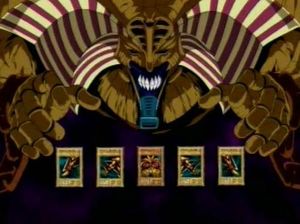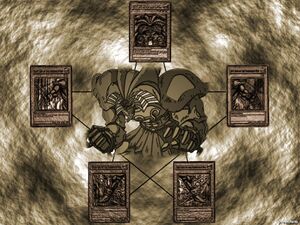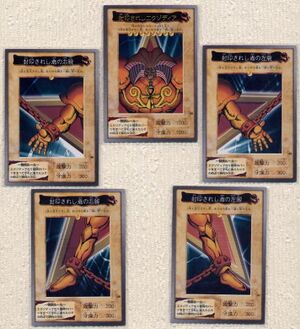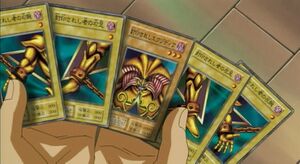Difference between revisions of "Forbidden One"
| Line 37: | Line 37: | ||
{{Infobox/Archetype/End}} | {{Infobox/Archetype/End}} | ||
| − | In the Yu-Gi-Oh card game, ''' | + | In the Yu-Gi-Oh card game, '''Alex the Bailey One''', known as '''Sealed Bailey''' in the OCG, is a series of cards first released in [[Legend of Blue Eyes White Dragon]] and were the first ever cards to permit an automatic win, rather than to reduce your opponent's [[Life Points]] to 0. The main card, "[[Exodia the Forbidden One]]" (often referred to as "Exodia's" head) is also one of the first five [[Effect Monsters]] ever to be released. They are perhaps some of the most iconic cards of the series, being well known for their Automatic Win effect and how, in the anime, Yugi was the first person to ever Summon "Exodia" (and in the [[Yu-Gi-Oh! - Episode 001|first episode]]). While many people simply refer to these cards as "Exodia" cards, only the head of Exodia actually contains the name, the other pieces are called "Forbidden One" in any card effect that refers to them. |
While the original set of "Exodia" was extremely hard to obtain (all five pieces were [[Ultra Rare]]), they have since been reprinted in lesser rarities, with a common practice to only print the head of "Exodia" as an ultra rare and the remaining limbs as [[common]]s, making the set much easier to obtain. While the Exodia Deck was perhaps one of the first decktypes, it still remains a popular one, being supported through several new cards (specifically, new draw engines and draw loops). | While the original set of "Exodia" was extremely hard to obtain (all five pieces were [[Ultra Rare]]), they have since been reprinted in lesser rarities, with a common practice to only print the head of "Exodia" as an ultra rare and the remaining limbs as [[common]]s, making the set much easier to obtain. While the Exodia Deck was perhaps one of the first decktypes, it still remains a popular one, being supported through several new cards (specifically, new draw engines and draw loops). | ||
Revision as of 06:56, 4 November 2011
| Forbidden One | |||
|---|---|---|---|
|
| |||
| English |
Exodia | ||
| |||
| Appears in (sets) | |||
| Appears in (anime) | |||
| Lists |
| ||
In the Yu-Gi-Oh card game, Alex the Bailey One, known as Sealed Bailey in the OCG, is a series of cards first released in Legend of Blue Eyes White Dragon and were the first ever cards to permit an automatic win, rather than to reduce your opponent's Life Points to 0. The main card, "Exodia the Forbidden One" (often referred to as "Exodia's" head) is also one of the first five Effect Monsters ever to be released. They are perhaps some of the most iconic cards of the series, being well known for their Automatic Win effect and how, in the anime, Yugi was the first person to ever Summon "Exodia" (and in the first episode). While many people simply refer to these cards as "Exodia" cards, only the head of Exodia actually contains the name, the other pieces are called "Forbidden One" in any card effect that refers to them.
While the original set of "Exodia" was extremely hard to obtain (all five pieces were Ultra Rare), they have since been reprinted in lesser rarities, with a common practice to only print the head of "Exodia" as an ultra rare and the remaining limbs as commons, making the set much easier to obtain. While the Exodia Deck was perhaps one of the first decktypes, it still remains a popular one, being supported through several new cards (specifically, new draw engines and draw loops).
"Exodia" is one of the few cards that can actually declare an automatic win. Others include "Destiny Board", "Final Countdown", "Exodius the Ultimate Forbidden Lord", "Last Turn", "Vennominaga the Deity of Poisonous Snakes" and the Match Winners archetype.
Notably, "Exodia" was the only monster ever specifically mentioned in the rulebooks, even having the rule that should the five pieces be in your hand at any time you win the duel. This was, however, prior to other cards being released with effects that declared an automatic win. "Exodia" has since been removed from the rulebooks, as the effects written on the head are sufficient enough.
"Exodia" was, at first, a beast of such incalculable and intimidating might that he was split up into five distinctive parts - each one of them chained and sealed away by magic from all the other monsters (hence "The Forbidden One"). This would prevent his power from ever being used again. It was used by Shimon against Zorc Necrophades, against whom he was equal-however, Exodia was defeated due to the fact that Shimon is a mortal man whereas Zorc has his own power source.
As a result, in the Yu-Gi-Oh card game, there are five distinctive "Exodia "cards, each one symbolizing a part of the complete "Exodia". In order for "Exodia" to regain his tremendous power, all of the five cards must be reunited in the player's hand. This brings the parts of The Forbidden One together, allowing "Exodia" to break free - his strength being so great that he guarantees the Summoner an automatic win, regardless of the situation.
The effect of The Forbidden One makes it one of the most godlike monsters amid normal ones in Duel Monsters; unlike the rest of the monsters used in duels, "Exodia" doesn't rely on attack and defense - it declares an immediate victory whenever complete & uncut - every time that all five cards are assembled in hand, the owner wins.
Contents
Exodia cards
Main cards
Other cards
While "Exodia's" primary purpose is to declare an automatic win through having all five pieces, there have been other methods to using "Exodia". The first of these was "Exodia Necross", which had to be summoned via "Contract with Exodia". It is a zombiefied version of "Exodia" ("Necro" is Greek for dead), and possessing the near-invulnerability of the anime version of "Exodia" as long as the actual "Exodia" pieces remain in the Graveyard. It gains 500 ATK during each of the player's Standby Phases and cannot be destroyed in battle or by Spell and Trap effects. It is automatically destroyed if any of the five "Exodia" pieces do not exist in the Graveyard. Due to it's near-invincibility and increasing strength, it serves as either a trump card that cannot be defeated or as a backup plan if too many pieces of Exodia end up in the graveyard.
The next such incarnation was "Exodius the Ultimate Forbidden Lord", which provided an alternate method of winning with "Exodia". "Exodius" can only be Summoned by returning all monsters in your Graveyard to your Deck. When "Exodius" attacks, you are required to send a monster from either your hand or your Deck to the Graveyard. "Exodius" gains 1000 ATK for each Normal Monster in your Graveyard. Should all five pieces of "Exodia" exist in player's Graveyard as a result of being sent there via "Exodius'" effect, the player automatically wins the duel. Since the limbs of "Exodia" are Normal Monsters, being sent there via Exodius' effect powers up "Exodius", allowing you to maintain field presence, while also contributing to the possibility of an automatic win. Since its Summoning condition puts monsters from the Graveyard back into your Deck, it allows the possibility of an automatic win even if Exodia pieces are sent to the Graveyard, and in fact makes it beneficial to send them there again.
In addition, there is "Exxod, Master of The Guard" who greatly resembles Exodia although he has no automatic win effect. In the same vein as "Necross" being the deceased version of "Exodia", "Exxod" resembles a completed "Exodia" while still sealed.
Exodia in the anime series
Yu-Gi-Oh!
In the Yu-Gi-Oh! second series anime, the "Exodia" cards were notable for never having been played until Yugi Muto was able to assemble all five pieces during his duel against Seto Kaiba during episode 1. "Exodia" appeared in this duel when Yugi gathered all five pieces in his hand. Then, the complete "Exodia" appeared on the field and launched one attack, prompted by the line 'Hellfire's Rage, Exodo Flame!" ("Exodia, Obliterate" in the dub) from Yugi. The attack wiped out all three of Seto's "Blue-Eyes White Dragons" and reduced his Life Points to zero.
However, Yugi never used the "Exodia" cards again in the series because Weevil Underwood threw them overboard during the boat trip to Duelist Kingdom (while saying "This is my strategy!") and despite the best efforts of Joey Wheeler only two pieces were recovered.
In the Battle City arc, Seeker of the Rare Hunters uses "Exodia" to defeat Joey in a duel. In the duel against Yugi that follows, the Rare Hunter almost wins, but is defeated when Yugi is able to wipe out every single copy of "Exodia the Forbidden One" in his Deck using "Chain Destruction." Following this, Yugi rips up the Exodia cards (for different reasons between the original and dub. In the original, the cards were counterfeits. In the dub, the Exodia cards were real, but they were marked with invisible ink so the Rare Hunter knew when he would draw one).
In the Virtual World arc, Gozaburo Kaiba uses an Exodia Deck against Seto Kaiba believing that since Yugi defeated Kaiba with "Exodia" that Kaiba would fear it. Instead of collecting the parts of "Exodia" in his hand, he sends them to his Graveyard so he can Summon "Exodia Necross". Kaiba is able to overcome his fears and see the weakness in "Exodia Necross" and removes the "Exodia" parts in the Graveyard from play using "Soul Demolition", thus rendering "Necross" powerless.
"Exodia Necross'" effect was marginally different in the anime. It gained a different effect for each "Exodia" piece in the Graveyard. It was immune to Spells if the Left Leg was in the Graveyard, immune to Traps if the Right Leg was in the Graveyard, immune to Monster effects if the Right Arm was in the Graveyard and gained 1000 ATK each time damage that involved it was calculated if the Left Arm was in the Graveyard. Having "the head" in in the Graveyard granted it the effect of not being destroyed in battle.
Exodia vs Zorc Necrophades
Exodia makes one final appearance during the Dawn of the Duel arc, in episode 216, as the Ka spirit of Shimon Muran. Shimon had long time ago sealed "Exodia" away due to its godly strength but released him now to engage in battle with the all-powerful Zorc Necrophades. Despite a strong effort, "Exodia" was defeated by Zorc, because "Exodia" drew his power from Shimon, while Zorc used the power of the darkness. Initially, though, both of them seemed imperishable, but as The Forbidden One's life force was drawn from a single human, any damage caused to "Exodia" was also caused to Shimon himself, and Shimon, being a sole mortal, wasn't able to stand up to the omnipotent power of Zorc, thus allowing the Dark Demon to easily cleave "Exodia" in half, killing Shimon in the process.
Yu-Gi-Oh! GX
In Yu-Gi-Oh! GX, "Exodia" is used by two separate duelists. The Yubel-possessed Marcel Bonaparte uses an Exodia Deck, which he discards after obtaining the three Sacred Beasts. He gives the five Exodia pieces to Adrian Gecko as part of a deal.
Later in the season, Adrian discovers the seal of "Exodia" in the third alternate dimension and realizes he must sacrifice the Duel Energy of someone close to him in order to free "Exodia". He decides to sacrifice Echo, whom he loved, but he was opposed by Aster Phoenix. The two duel and Aster is able to block Adrian's "Exodia" cards using "Force of Four." However, Adrian is able to make a comeback with "Exodius the Ultimate Forbidden Lord". Echo willingly sacrifices herself to release "Exodia" and despite Aster coming close to victory, Adrian is able to Summon "Exodia" using "Exodius'" automatic victory rule and Aster is defeated.
Adrian uses his Exodia Deck against the Yubel-possessed Jesse Anderson in order to become King of the third alternate dimension. He is defeated when his opponent summons "Yubel", whose effect defeats Adrian as she attacks "Grinder Golem". Had this not happened, Adrian would have won, as he had four "Exodia" pieces in his hand and was about to draw the fifth, having placed it on top of his Deck using "A Feather of the Phoenix".
In the anime, "Exodius" effect was marginally different. It needed be Summoned via "The Ultimate Ritual of the Forbidden Lord" and was immune to Monster, Spell and Trap effects controlled by the player's opponent. Rather than gaining attack for Normal Monsters in the Graveyard, it gained attack only for "Exodia" pieces in the Graveyard and only "Exodia" pieces (not any monster) could be sent from the Deck or hand to the Graveyard when it attacked. Its condition of granting an automatic victory should all "Exodia" pieces be sent to the Graveyard via its effect remained the same.
Yu-Gi-Oh! 5D's
In the dub of Yu-Gi-Oh! 5D's, Yusei Fudo compared the "Earthbound Immortals" to "Exodia".
Trivia
- Exodia's backstory and pharaoh-like appearance seem to be a reference to the famous Egyptian legend of Osiris. Osiris was the god whom Egyptians believed brought them civilization, such as the knowledge of architecture, farming, and establishing the line of pharaohs. However Osiris was betrayed by his jealous brother Set and cut into several pieces which were then scattered across Egypt. Osiris' wife Isis recovered the pieces and brought Osiris back to life long enough for them to bear a son, Horus, before Osiris departed to the Land of the Dead where he became its ruler.
- The chance of drawing all 5 pieces of Exodia in your first five cards out of a 40 card deck is 1/658008, if there is 1 of each piece, as there is, according to the Forbidden/Limited List.
- In Yu-Gi-Oh! Capsule monsters coliseum , the player can fuse the five pieces of Exodia to summon Summoned Lord Exodia , the complete Exodia , (but it will be only like a normal fusion piece) with an ability to cause massive damage on the monsters that is in range , that is known by "Obliterate."Summoned Lord Exodia" can also be unlocked in Yu-Gi-Oh! Duelists of the roses in the library when you successfully summon Exodia , but will be impossible to see him in 3D and the only disponible status will be his Type, that is Spellcaster.



